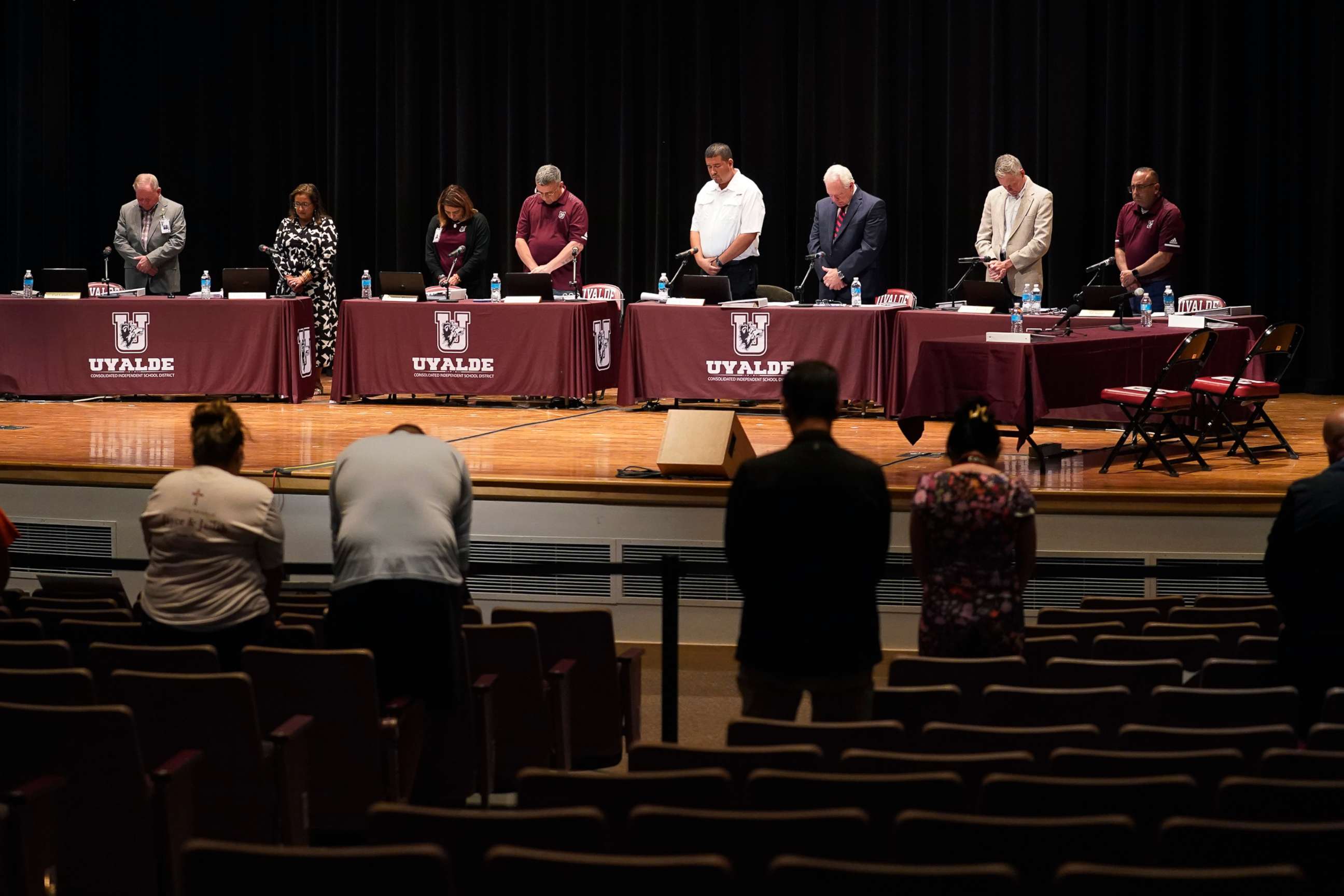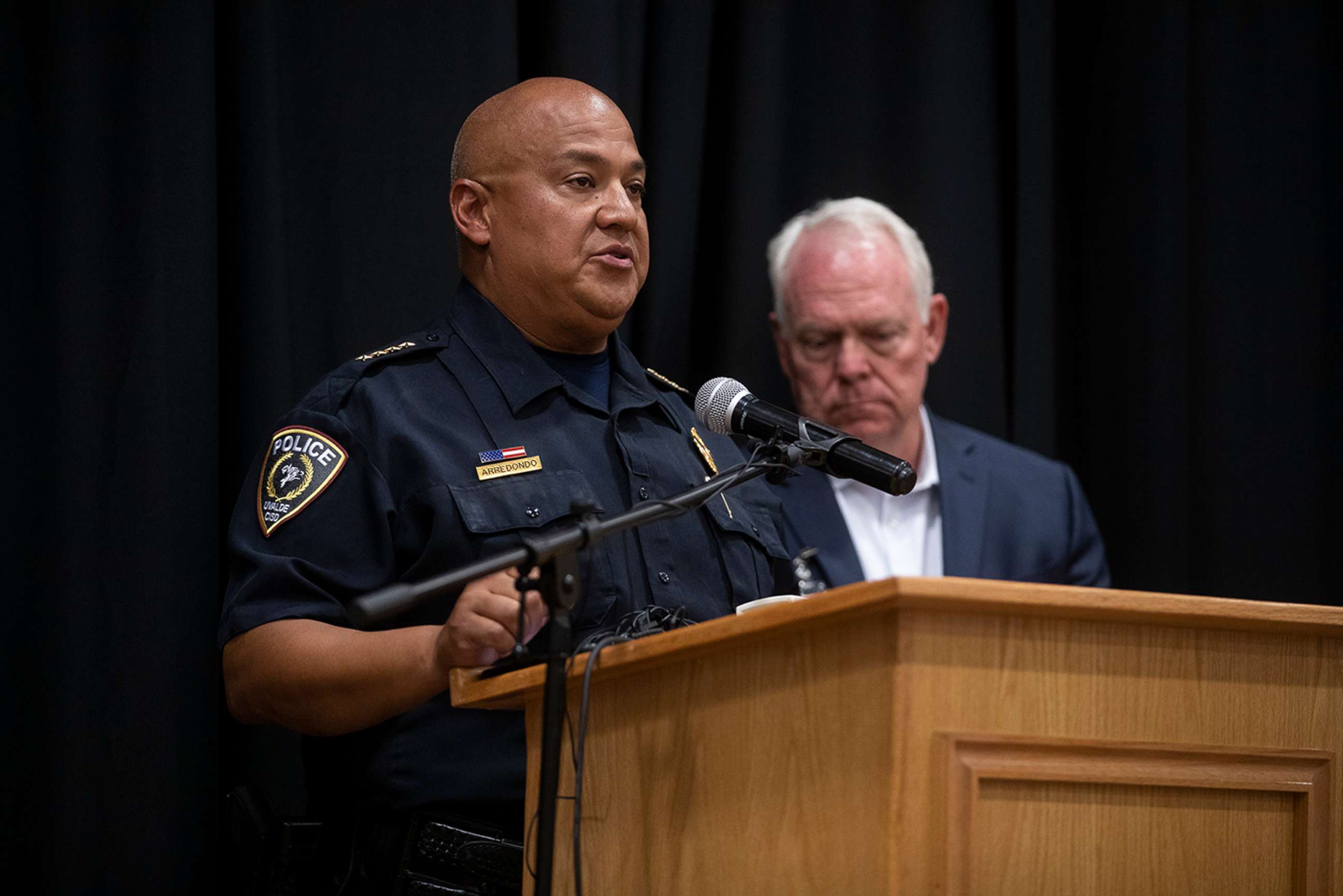'Take responsibility': Experts push back on Arredondo's response to his termination
The ex-chief, who was fired Wednesday, says he was forced to be the "fall guy."
Pete Arredondo, who was fired this week as Uvalde School District police chief after the flawed police response to the mass shooting at Robb Elementary School, said Wednesday that he had been "forced into the role of the 'fall guy'" despite taking "all reasonable actions" -- but some law enforcement experts say his claims don't stand up to scrutiny.
The school board in Uvalde, Texas, voted unanimously Wednesday night to terminate its embattled police chief, a move that was met with approval from a community still demanding accountability more than three months after one of the deadliest school shootings in U.S. history.
But according to a 17-page statement prepared by Arredondo's attorney, Arredondo believes his firing "demonstrates that no good deed goes unpunished."
"Chief Arredondo hopes at least those who are willing to listen, understand that he is, and has been ... forced into the role of the 'fall guy' and 'the sacrificial lamb,'" the statement said.
The statement offered Arredondo's most thorough defense of his actions to date and sought to redirect blame for the 77 minutes it took officers to engage and kill the 18-year-old gunman, saying that he was not the on-site commander.
But experts who evaluated Arredondo's response told ABC News that many of his claims conflict with both the facts of the case and basic active shooter response protocols.
"Leaders take responsibility for their actions," Eva Guzman, a former Texas Supreme Court justice and member of the Texas legislative committee that investigated the Robb Elementary shooting, told ABC News following Arredondo's firing. "Pete Arredondo exercised poor judgment and he is attempting to shift the focus."
Arredondo did not appear at his termination hearing on Wednesday and has only given one interview, to The Texas Tribune, since the May 24 shooting. He has contested his firing and requested his job back, including back pay, on the grounds that the school district violated his constitutional rights.
Incident commander?
The legislative committee's probe found that "a major error ... was the failure of any officers to assume and exercise effective incident command." As one of the first responding officers and the leader of the agency with jurisdiction over the school, Arredondo was the "natural person to assume command," the committee said.
Arredondo, however, has repeatedly said he did not consider himself the on-scene commander, and he reiterated that in the statement his lawyer delivered Wednesday.
"[Arredondo] could not have served as the incident commander and did not attempt to take that role as he was at the front line of the incident," the statement said.
But according to the Texas legislative committee report, the school district's own written active shooter plan had assigned Arredondo "to assume command and control" during an active shooter incident.

Beyond that, law enforcement experts interviewed by ABC News said the role fell to Arredondo by default. John Cohen, a former Homeland Security official who is now an ABC News consultant, said that accepted active shooter training stipulates that, by default, the incident commander is the senior official of the jurisdiction in which the incident took place.
"At the end of the day, this chief was in command on the day that an individual was able to walk into a school and gun down 21 people including 19 kids," said Cohen, who is also a former police officer. "While there may have been issues with door locks and communication, at the end of the day, he owns it."
Active shooter protocol
In his statement, Arredondo argued that during the police response to the shooting, he acted "bravely" and "took all reasonable actions to prevent further injuries or loss of life, as the active shooter protocol demands."
But experts ABC News spoke with took issue with Arredondo's characterization of active shooter protocols, which have been in place since the 1999 mass shooting at Columbine High School in Littleton, Colorado. The post-Columbine protocols stipulate that the sole focus of first responders is to immediately locate and neutralize the shooter or shooters.
By failing to breach the Robb Elementary School classroom containing the gunman -- and by waiting more than an hour for additional manpower and resources to arrive before confronting the gunman -- Arredondo violated the key tenets of those protocols, experts said.
"The doctrine -- the key, core, hyper-protocol -- is immediate entry and eliminate the threat," said Robert Boyce, the former chief of detectives with the New York Police Department and now an ABC News contributor. "The key element of any active shooter is to go in and terminate the threat immediately, and [Arredondo] didn't do that."
On-scene priorities
By the time officers arrived at the school, the gunman had already entered the classroom and begun firing. When the first responders first attempted to breach the classroom, the gunman turned his fire on them, wounding two officers through the doorway.
"[Arredondo] immediately realized that ... children and employees in the rooms across the hall were in imminent danger," his attorney's statement read. "So [Arredondo] felt it imperative to evacuate those rooms ... while they developed a means to get to the shooter."
Arredondo has repeatedly stood by his decision to evacuate students and staff elsewhere in the building before engaging the shooter. In his statement, Arredondo's lawyer asked rhetorically, "Would the District have preferred a gunfight with officers in the hallway...? And what if some of [the students] were killed by police officer fire?"
Experts ABC News consulted said they recognized Arredondo's concern for other students as a reasonable one -- but again suggested that his decision to prioritize the evacuations before engaging the shooter violated standard procedure for active shooter response.

Jarrod Burguan, the former police chief in San Bernardino, California, said that, in turning his attention to others, Arredondo implicitly began treating the shooter as a barricaded subject, not an active threat to those who were still trapped with the gunman in the classroom.
"The decision to transition to a barricaded suspect [situation] would be the wrong decision in that case," said Burguan, who is also an ABC News contributor. "Because the primary goal of an active shooter response is to stop the attack. And they failed to stop the shooter."
ABC News' Olivia Osteen, Patrick Linehan and Hannah Prince contributed to this report.




